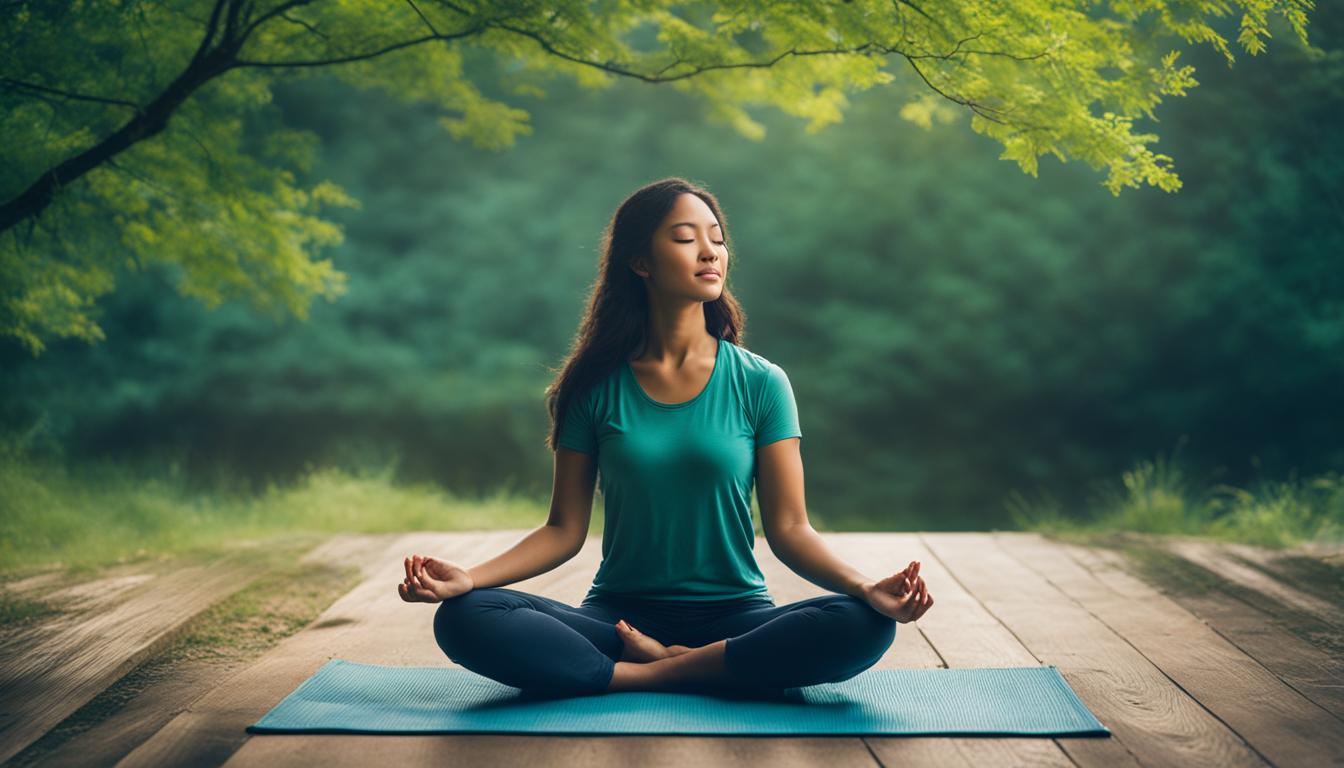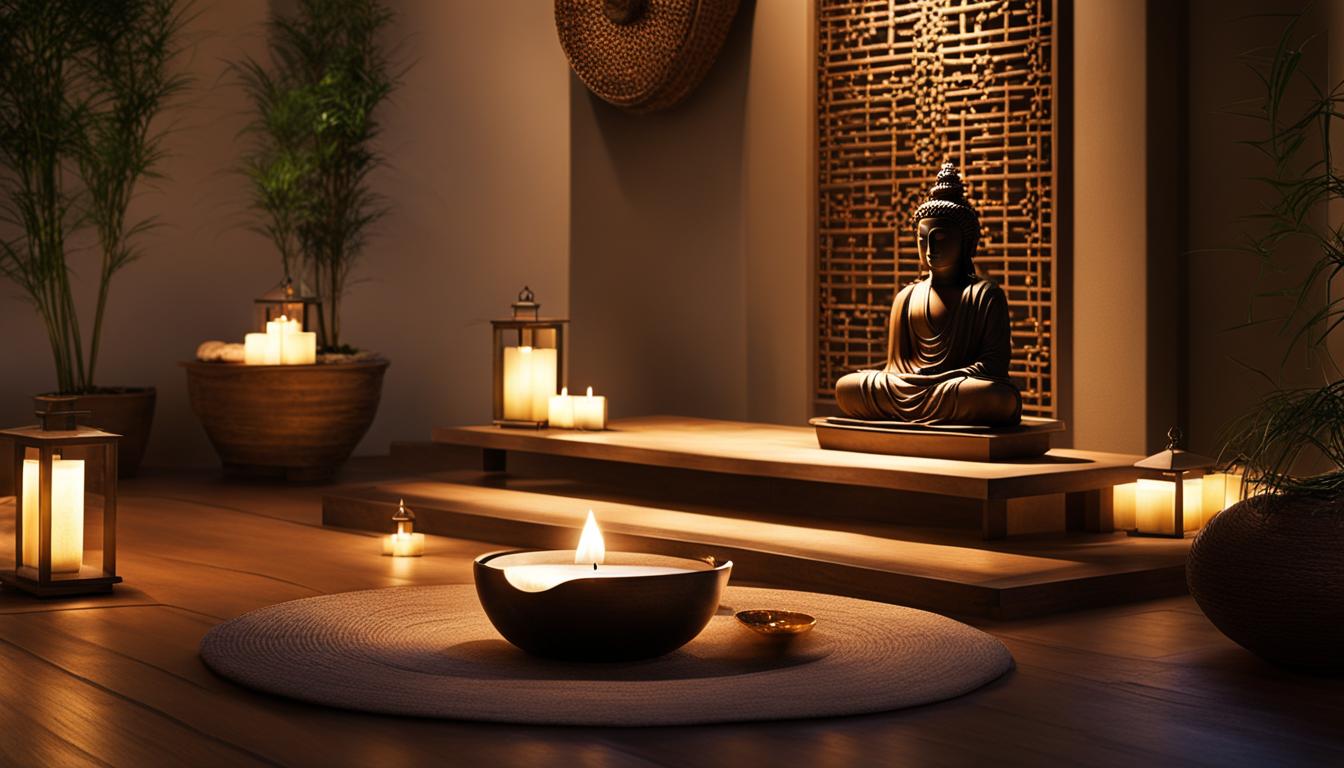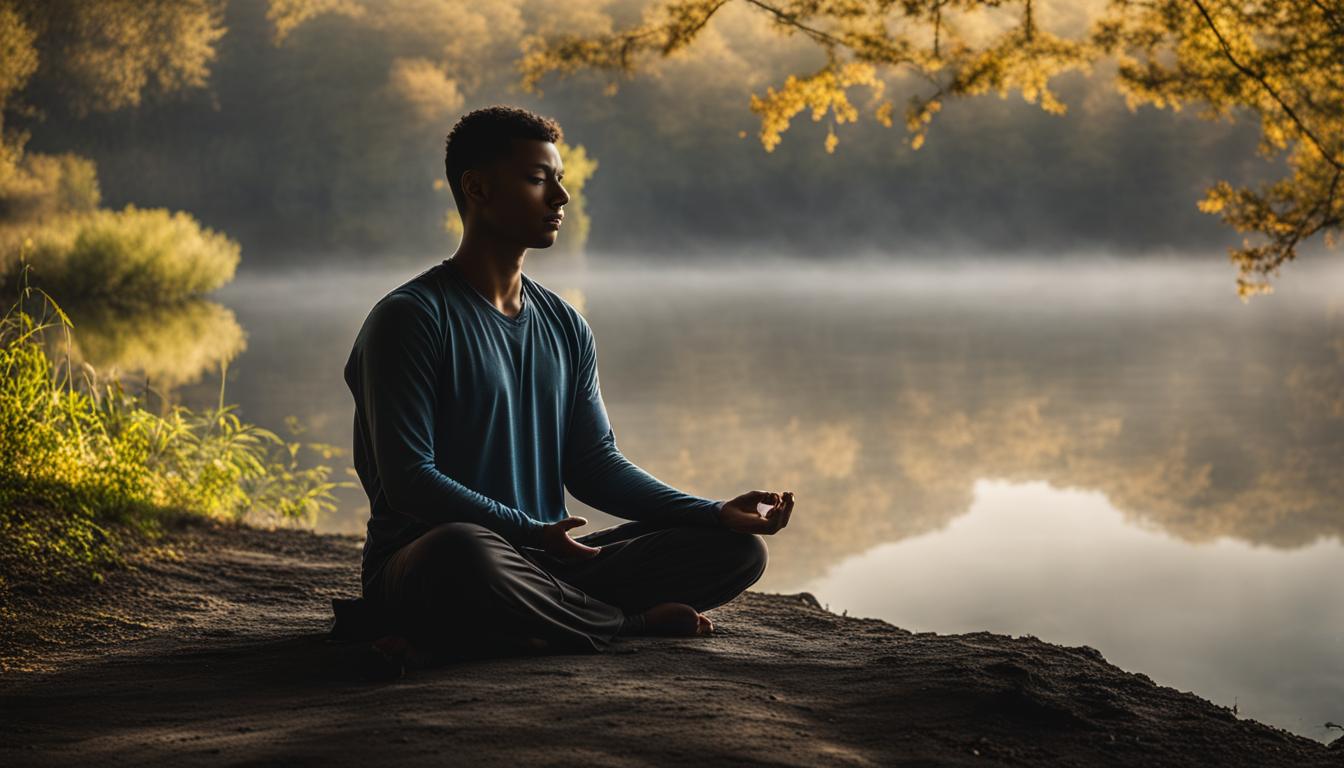Disclosure: This Post Contains Affiliate Links; We earn a commission on purchases.
Starting a meditation practice can be intimidating, especially for beginners who may feel unsure or hesitant. However, with the right approach and mindset, anyone can start meditating with confidence and unlock the benefits of mindfulness and inner peace. In this article, we will explore various strategies and techniques to help beginners overcome their hesitation and begin their meditation journey with confidence.
Key Takeaways:
- Establishing a consistent meditation schedule can help build confidence and integrate the practice into your daily routine.
- Creating a dedicated and peaceful space for meditation can enhance focus and relaxation.
- Participating in group meditations or joining meditation communities can provide support and accountability.
- Incorporating virtual reality or guided meditation platforms can enhance the meditation experience for beginners.
- Combining yoga with meditation can be a gentle introduction to the practice and promote mental focus.
Create a Consistent Schedule
One of the essential steps in building meditation confidence is creating a consistent schedule. By dedicating a specific time of day to your practice, you train your brain to associate that time with relaxation and stillness. It is not necessary to adhere to a strict schedule; rather, find a time that works best for you and commit to it daily. Consistency is key in reaping the mental health benefits of meditation.
A consistent schedule helps in establishing a routine and integrating meditation into your daily life. It creates a sense of discipline and helps you prioritize self-care. Remember, even a few minutes of meditation each day can make a significant difference in your overall well-being.
When creating your meditation schedule, choose a time when you are least likely to be interrupted or distracted. This could be early in the morning before starting your day, during a lunch break, or in the evening before bedtime. Experiment with different times to find what works best for you.
To enhance the effectiveness of your meditation practice, consider incorporating the following tips:
Set Realistic Goals:
Start with short meditation sessions, gradually increasing the duration as you become more comfortable. Setting realistic goals ensures that you can maintain consistency without feeling overwhelmed.
Create a Ritual:
Develop a pre-meditation ritual that prepares your mind and body for the practice. This could include dimming the lights, lighting a candle, or taking a few deep breaths to center yourself.
Find a Quiet Space:
Designate a quiet and peaceful area in your home where you can meditate without distractions. Ideally, choose a space with minimal noise or visual clutter.
Use an Alarm or Timer:
Set a gentle alarm or timer to signal the end of your meditation session. This prevents you from constantly checking the clock and allows you to fully immerse yourself in the practice.
Be Flexible:
While consistency is important, it’s also crucial to be flexible and adapt your schedule when necessary. Life happens, and there may be days when you are unable to meditate at your designated time. Instead of skipping your practice altogether, find an alternative time or adjust the duration to fit your circumstances.
By creating a consistent schedule for your meditation practice, you establish a strong foundation for building meditation confidence. Remember, everyone’s journey is unique, so be patient with yourself and allow the process to unfold at its own pace.
Create a Meditative Space
One of the key aspects of building meditation confidence is creating a dedicated and peaceful space for your practice. Having a designated area where you can retreat and focus solely on your meditation can significantly enhance your experience, especially in the early stages. By curating a serene environment, you can set the stage for a more focused and calming meditation experience.
- Find a quiet area: Look for a quiet corner or room in your home where you can sit comfortably without distractions. It should be a place where you can feel at ease and relax.
- Clear the clutter: Declutter the space to create a clean and serene atmosphere. Remove any unnecessary items or visual distractions that might disrupt your focus.
- Add comfort: Place a cushion, mat, or chair in the designated area to ensure a comfortable seating position during your meditation practice. Choose whatever seating option works best for you.
- Set the ambiance: Consider the lighting and temperature in the space. Soft, warm lighting and a pleasant room temperature can contribute to a calming atmosphere.
- Create a visual focal point: You may choose to include elements like a small indoor plant, a meditation altar, or a calming artwork to help center your attention and create a sense of tranquility.
Remember, your meditative space should be a reflection of your personal style and preferences. It can be as simple or as elaborate as you desire. The goal is to create an environment that promotes a peaceful and undisturbed meditation practice.
Meditate with Others
While meditation may seem like a solitary practice, there is immense value in meditating with others. Joining a meditation class or participating in group meditation sessions can amplify your experience and provide a sense of community. Meditating with others not only helps you break free from your own thought loops but also adds a level of accountability and support to your practice. Consider exploring local meditation groups or virtual meditation communities to enhance your meditation journey.
Meditating with others offers a unique opportunity to deepen your practice and learn from experienced meditators. In a group setting, you can benefit from the positive energy and collective focus, making it easier to let go of distractions and find a state of peace. Additionally, sharing your meditation experiences and insights with fellow practitioners can be incredibly enriching and inspiring.
The Benefits of Group Meditation
1. Enhanced Focus: Meditating in a group can help improve your concentration and discipline. The collective energy and shared intention create a focused atmosphere, making it easier to stay present and centered during your meditation.
2. Deeper Connection: Group meditation allows you to connect with like-minded individuals who share a similar interest in mindfulness and personal growth. Building connections with others who are on a similar journey can provide a sense of belonging and support.
3. Accountability: When you meditate with others, you’re more likely to stay committed to your practice. The regularity of group meditation sessions keeps you accountable and motivated to show up and dedicate time to your inner well-being.
4. Collective Energy: Meditating as a group generates a powerful collective energy that can enhance the overall experience. The combined focus and intention create a supportive and uplifting atmosphere, allowing you to tap into deeper states of relaxation and inner peace.
5. Guided Meditation: Group meditation sessions often include guided meditations led by experienced teachers or facilitators. These guided sessions are especially beneficial for beginners, as they provide structure and guidance in developing a meditation practice.
Whether you choose to join a local meditation group or participate in virtual group meditations, the experience of meditating with others can be transformative. It offers a supportive community and amplifies the benefits of meditation, helping you find inner peace and cultivate mindfulness in your everyday life.
Remember, meditation is a personal journey, and there is no one-size-fits-all approach. Explore different options, find a group that resonates with you, and embrace the sense of connection and growth that comes from meditating with others.
Image: A serene image depicting a person meditating in a peaceful natural setting.
Meditate Virtually
For beginners looking to enhance their meditation practice, virtual meditation offers a unique and immersive experience. By incorporating immersive technology into your sessions, you can create a serene and focused environment that supports relaxation and mental calmness.
One way to explore virtual meditation is through virtual reality (VR) headsets. These devices transport you to peaceful and picturesque settings, allowing you to escape the distractions of the physical world and dive deeper into your meditation practice. With the visual and auditory stimuli provided by VR, you can easily immerse yourself in a tranquil environment conducive to mindfulness and self-reflection.
Another option is to use virtual meditation apps. These apps provide a variety of guided meditation programs designed specifically for beginners, with step-by-step instructions and soothing audio. They often include features such as ambient nature sounds, calming music, and virtual guides to assist you in your meditation journey. These apps offer flexibility and convenience, allowing you to meditate anytime and anywhere.
Mental Focus and Calmness
Research has shown the benefits of virtual meditation in enhancing mental focus and promoting a sense of calmness. By adding a visual and auditory dimension to your practice, virtual meditation can deepen your level of concentration and help quiet the mind. The immersive nature of VR and virtual meditation apps creates a sense of presence, making it easier to stay focused and fully engaged in the present moment.
“Virtual meditation introduces a new level of serenity and mindfulness to the practice, helping beginners achieve a state of mental clarity and inner peace.” – Dr. Laura Thompson, Meditation Expert
Guided Meditation Support
Virtual meditation also offers guided meditation programs tailored for beginners. These guided sessions provide structure and support, making it easier for beginners to navigate their meditation practice. With guided virtual meditations, you can follow along with experienced instructors who walk you through various mindfulness techniques and help you develop a solid foundation in meditation.
Watching guided meditation videos is another way to incorporate virtual support into your practice. You can find a wide range of guided meditation videos online, covering different meditation techniques and focusing on specific goals like stress reduction, relaxation, or building self-compassion. These videos can serve as valuable resources for beginners seeking guidance and inspiration in their meditation journey.

Pros and Cons of Virtual Meditation
| Pros | Cons |
|---|---|
| Creates a serene and immersive environment | Requires initial investment in VR equipment |
| Offers guided meditation programs for beginners | May not provide the same level of sensory experience as physical meditation spaces |
| Provides flexibility and convenience | Requires familiarity with technology and apps |
When incorporating virtual meditation into your practice, it’s essential to consider both the benefits and drawbacks. While virtual meditation can provide a unique and enjoyable experience, it may not fully replicate the sensory experience of physical meditation spaces. However, it offers convenience and accessibility, making it a viable option for beginners looking to explore meditation in a modern and immersive way.
Incorporate Yoga
Combining yoga with meditation can be an effective way to ease into the practice, especially for those who find it challenging to sit still. The synchronized movements and breathwork in yoga can help improve mental focus and reduce stress. By incorporating yoga postures or a gentle flow before or after meditation, beginners can find a more accessible entry point to the practice while reaping the benefits of both yoga and meditation.
The Benefits of Yoga in Meditation
Yoga and meditation are complementary practices that support each other in various ways. Here are some key benefits of incorporating yoga into your meditation routine:
- Improved Mental Focus: Yoga postures require concentration and attention to alignment, which can train the mind to stay present and focused. This increased mental focus can directly enhance your meditation practice.
- Reduced Stress: The mindful movements and breathing techniques in yoga activate the body’s relaxation response, reducing stress and promoting a sense of calm. This relaxed state can facilitate a deeper meditation experience.
- Physical Comfort: Engaging in gentle stretching and loosening up the body through yoga can alleviate physical tension, making sitting for meditation more comfortable and sustainable.
- Balance of Energy: Yoga helps balance the energy in the body by clearing stagnant energy and promoting the flow of prana (life force energy). This harmonious energy balance can create a more receptive state for meditation.
By combining yoga and meditation, beginners can discover a holistic approach to cultivating mindfulness, building meditation confidence, and nurturing the mind-body connection.
Tips for Incorporating Yoga and Meditation
If you’re new to both yoga and meditation, here are a few tips to help you incorporate them effectively:
- Start Slow: Begin with simple yoga poses and focus on linking your breath with each movement. Gradually increase the duration and intensity of your practice as you build strength and flexibility.
- Choose a Suitable Style: Explore different styles of yoga to find one that resonates with you. Hatha, Yin, and Restorative yoga are particularly suitable for meditation beginners as they emphasize gentle movements and longer holds.
- Practice Mindful Breathing: Pay attention to your breath throughout your yoga practice, focusing on deep, smooth inhalations and exhalations. This awareness of the breath encourages a meditative state of mind.
- Create a Seamless Transition: Transition from yoga to meditation by finding a comfortable seated position and gradually shifting your focus from the physical sensations in your body to your breath or a chosen point of concentration.
- Listen to Your Body: Respect your body’s limitations and modify yoga poses as needed. Avoid pushing yourself too hard and always prioritize safety and self-care.
By combining the mindful movements of yoga with the introspective practice of meditation, beginners can cultivate a deeper sense of peace, harmony, and self-awareness. Start your journey towards building meditation confidence by incorporating yoga into your daily routine.
Start with Breathwork
Controlled breathwork is a powerful technique to cultivate a state of stillness and calm the mind. Many meditation practices revolve around breath awareness, as focusing on the breath provides a constant anchor and helps in reducing intrusive thoughts.
Beginners can start by simply observing their breath, gradually slowing it down, and paying attention to the sensation of inhaling and exhaling. Breathwork can be practiced as a standalone meditation technique or as a preparatory step before diving into a more traditional meditation practice.
By incorporating breathwork into your meditation routine, you can:
- Center and ground yourself
- Find inner calm and clarity
- Reduce stress and anxiety
- Enhance focus and concentration
Take a few minutes each day to connect with your breath and experience the transformative power of this simple yet profound technique.
Remember, proper posture plays an essential role in breathwork. Sit comfortably, with your back straight and shoulders relaxed. You can sit on a cushion or chair, ensuring that your feet are grounded and your hands resting gently on your lap.
| Breathwork Techniques | Instructions |
|---|---|
| Diaphragmatic breathing | Lie down or sit in a comfortable position. Place one hand on your abdomen, just below your ribcage, and the other on your chest. Take a slow, deep breath in through your nose, allowing your belly to rise as you fill your lungs with air. Exhale slowly through your mouth, feeling your abdomen fall. Repeat for several breaths. |
| Square breathing | Sit in a relaxed position. Inhale slowly through your nose for a count of four, allowing the breath to fill your lungs. Hold your breath for a count of four. Exhale slowly through your mouth for a count of four. Hold your breath out for a count of four. Repeat for several rounds. |
| Nadi Shodhana (Alternate Nostril Breathing) | Sit comfortably. Using your right hand, place your index and middle fingers gently on your forehead, between your eyebrows. Close your right nostril with your thumb and inhale deeply through your left nostril. Close your left nostril with your ring finger, release your thumb, and exhale through your right nostril. Inhale through your right nostril, close it with your thumb, and exhale through your left nostril. Repeat for several rounds, alternating nostrils. |
Remember, breathwork is a deeply personal practice, and what works for one person may vary for another. Experiment with different techniques and find the ones that resonate with you. Incorporating breathwork into your meditation routine will help you foster a deeper connection with yourself and create a strong foundation for your meditation practice.
Enhance with Music
Adding soothing music or calming sounds to your meditation practice can enhance relaxation and create a peaceful atmosphere. Research suggests that certain music styles, particularly New Age or instrumental tracks, can help reduce stress and promote a deeper state of relaxation. Experiment with different types of music to find what resonates with you and supports your meditation practice.
Music has been used for centuries as a tool to aid in meditation. Its rhythmic patterns and soothing melodies can help calm the mind, allowing you to enter a deeper state of relaxation and focus. Whether it’s soft piano music, nature sounds, or chanting mantras, finding the right soundtrack for your meditation can greatly enhance your experience.

When selecting music for meditation, consider the following:
- Choose instrumental or ambient tracks: Music without lyrics can prevent distraction and allow you to focus solely on your meditation practice.
- Experiment with different genres: Explore various music genres, such as classical, ambient, or world music, to find the style that resonates with you and creates the desired atmosphere.
- Pay attention to the tempo: Opt for slower-paced music that promotes relaxation and a sense of tranquility.
- Add nature sounds: Incorporating sounds of nature, such as gentle rain or ocean waves, can create a serene and calming ambiance.
In addition to pre-recorded tracks, you can also explore live performances or guided meditation music. Many meditation apps and online platforms offer a wide selection of meditation music specifically designed to enhance the meditative experience.
Comparing Different Music Genres for Meditation
| Genre | Characteristics | Benefits |
|---|---|---|
| Classical | Elegant, composed, melodic | Enhances focus and concentration |
| Ambient | Ethereal, atmospheric, minimalistic | Induces relaxation and deep introspection |
| New Age | Soothing, spiritual, transcendent | Fosters a sense of inner peace and harmony |
| Nature Sounds | Gentle rain, flowing rivers, chirping birds | Creates a natural and calming environment |
“The right music can be a powerful ally in our meditation practice, helping us relax, let go, and enter a state of deep presence.” – Leo Babauta
Remember, the music you choose should complement your meditation practice and align with your personal preferences. Experiment, explore, and let the power of music enhance your mindful meditation journey.
Embrace Wandering Thoughts
During meditation, it is perfectly normal for the mind to wander, especially for beginners. Instead of feeling frustrated or discouraged, it is essential to embrace these wandering thoughts with curiosity and non-judgment. Recognize that this is a natural part of the meditation practice and gently guide your attention back to your chosen point of focus, whether it’s your breath, a mantra, or an image.
By normalizing the experience of wandering thoughts, beginners can cultivate patience and resilience in their meditation journey. Rather than harshly criticizing yourself for being unable to maintain complete focus, accept that distractions will arise. Embracing this aspect of meditation allows you to extend kindness and compassion to yourself, fostering a nurturing environment for growth.
Remember, meditation is a practice, and building confidence takes time. Each time you gently redirect your attention back to your chosen focus, you are strengthening your ability to stay present. Be patient with yourself and trust in the process.
Embracing Distractions: A Key Step in Building Meditation Confidence
Embracing distractions during meditation may seem counterintuitive, but it is an essential step in building meditation confidence. By acknowledging and accepting the wandering nature of the mind, beginners can develop a greater sense of self-awareness and resilience.
“In the midst of movement and chaos, keep stillness inside of you.” – Deepak Chopra
Deepak Chopra’s words remind us that even in moments of internal chaos, stillness can be found. By embracing wandering thoughts with a sense of curiosity rather than resistance, you tap into the power of inner tranquility.
Ultimately, remember that meditation is not about perfection or achieving a thoughtless state. It is about cultivating a deeper connection with yourself, finding moments of peace, and developing a stronger sense of presence in the midst of life’s distractions. By embracing wandering thoughts, you are strengthening your meditation practice and building confidence in your ability to find stillness within.
Conclusion
Starting a meditation practice can be a transformative journey towards finding inner peace and cultivating mindfulness. With the right strategies and techniques, beginners can overcome hesitation and build confidence in their meditation practice. By creating a consistent schedule, designing a dedicated meditative space, meditating with others, and incorporating various techniques like breathwork and yoga, individuals can embark on a path of self-discovery and tranquility.
It’s important to remember that meditation is a personal and adaptable practice. There is no one-size-fits-all approach, so it’s essential to find what works best for you. Experimentation and exploration will help you discover your own unique meditation style and bring a sense of calm and stillness to your daily life.
So, whether you are new to meditation or have already begun your practice, embrace the journey of starting meditation with confidence. Allow yourself to be open and patient as you explore different techniques and find the ones that resonate with you. Through consistent practice and a mindful approach, you can unlock the transformative power of meditation and find inner peace within.
Source Links
- https://www.mayoclinic.org/tests-procedures/meditation/in-depth/meditation/art-20045858
- https://insighttimer.com/kernelofwisdom/guided-meditations/meditation-for-fear-or-hesitation
- https://www.healthline.com/health/mind-body/9-tips-for-meditating-when-youre-an-overthinker
Ryan Conlon is a passionate advocate for mindfulness and meditation, dedicated to helping others discover the transformative power of these practices in their lives. As the founder of Daily Meditation, Ryan’s mission is to provide a sanctuary for individuals seeking peace, clarity, and well-being amidst the chaos of modern life. With a background in psychology and years of personal experience with meditation, Ryan brings a wealth of knowledge and insight to his work. Through Daily Meditation, he shares practical guidance, inspirational content, and expert resources to support others on their journey toward greater mindfulness, resilience, and inner peace.
Subscribe to Our Newsletter

















